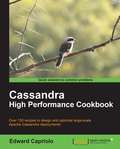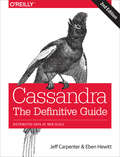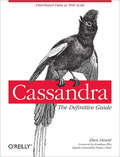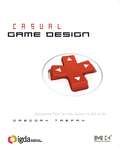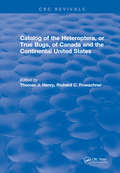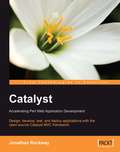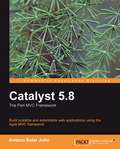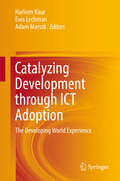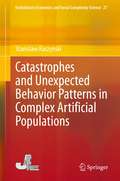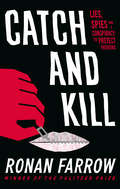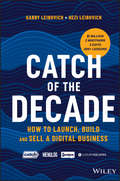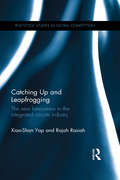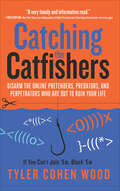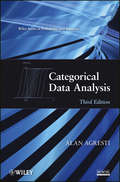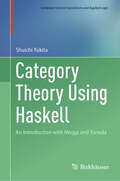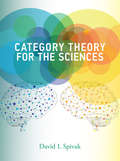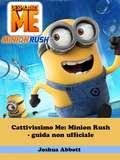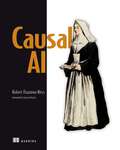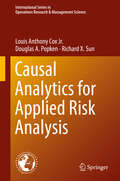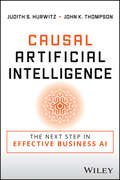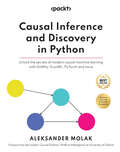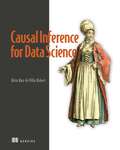- Table View
- List View
Cassandra High Performance Cookbook
by Edward CaprioloThis is a cookbook and all tasks are approached as recipes. A recipe describes a task and outlines the steps necessary to complete this task.Some recipes in the book are examples of writing code. An example of this is a recipe that stores and accesses the entries of a phone book in Cassandra. The recipe consists of a description of the program, a full code example is given, the example is run, the output is displayed, and finally the how it works section describes the process or code in greater detail.Other recipes in the book describe a task. An example of this is a recipe that takes a snapshot back up of data in Cassandra. This recipe contains a description of the process, it then shows how to run the snapshot command and confirm that it worked, it then explains what the snapshot command does behind the scenes, finally the 'see also' section references other related recipes such as the recipe to restore a snapshot.This book is designed for administrators, developers, and data architects who are interested in Apache Cassandra for redundant, highly performing, and scalable data storage. Typically these users should have experience working with a database technology, multiple node computer clusters, and high availability solutions.
Cassandra: Distributed Data at Web Scale
by Eben Hewitt Jeff CarpenterImagine what you could do if scalability wasn't a problem. With this hands-on guide, you’ll learn how the Cassandra database management system handles hundreds of terabytes of data while remaining highly available across multiple data centers. This expanded second edition—updated for Cassandra 3.0—provides the technical details and practical examples you need to put this database to work in a production environment.Authors Jeff Carpenter and Eben Hewitt demonstrate the advantages of Cassandra’s non-relational design, with special attention to data modeling. If you’re a developer, DBA, or application architect looking to solve a database scaling issue or future-proof your application, this guide helps you harness Cassandra’s speed and flexibility.Understand Cassandra’s distributed and decentralized structureUse the Cassandra Query Language (CQL) and cqlsh—the CQL shellCreate a working data model and compare it with an equivalent relational modelDevelop sample applications using client drivers for languages including Java, Python, and Node.jsExplore cluster topology and learn how nodes exchange dataMaintain a high level of performance in your clusterDeploy Cassandra on site, in the Cloud, or with DockerIntegrate Cassandra with Spark, Hadoop, Elasticsearch, Solr, and Lucene
Cassandra: The Definitive Guide
by Eben HewittWhat could you do with data if scalability wasn't a problem? With this hands-on guide, you'll learn how Apache Cassandra handles hundreds of terabytes of data while remaining highly available across multiple data centers -- capabilities that have attracted Facebook, Twitter, and other data-intensive companies. Cassandra: The Definitive Guide provides the technical details and practical examples you need to assess this database management system and put it to work in a production environment. Author Eben Hewitt demonstrates the advantages of Cassandra's nonrelational design, and pays special attention to data modeling. If you're a developer, DBA, application architect, or manager looking to solve a database scaling issue or future-proof your application, this guide shows you how to harness Cassandra's speed and flexibility. Understand the tenets of Cassandra's column-oriented structure Learn how to write, update, and read Cassandra data Discover how to add or remove nodes from the cluster as your application requires Examine a working application that translates from a relational model to Cassandra's data model Use examples for writing clients in Java, Python, and C# Use the JMX interface to monitor a cluster's usage, memory patterns, and more Tune memory settings, data storage, and caching for better performance
Cassandra: The Definitive Guide
by Eben Hewitt Jeff CarpenterImagine what you could do if scalability wasn't a problem. With this hands-on guide, you'll learn how the Cassandra database management system handles hundreds of terabytes of data while remaining highly available across multiple data centers. This expanded second edition--updated for Cassandra 3.0--provides the technical details and practical examples you need to put this database to work in a production environment.Authors Jeff Carpenter and Eben Hewitt demonstrate the advantages of Cassandra's non-relational design, with special attention to data modeling. If you're a developer, DBA, or application architect looking to solve a database scaling issue or future-proof your application, this guide helps you harness Cassandra's speed and flexibility.Understand Cassandra's distributed and decentralized structureUse the Cassandra Query Language (CQL) and cqlsh--the CQL shellCreate a working data model and compare it with an equivalent relational modelDevelop sample applications using client drivers for languages including Java, Python, and Node.jsExplore cluster topology and learn how nodes exchange dataMaintain a high level of performance in your clusterDeploy Cassandra on site, in the Cloud, or with DockerIntegrate Cassandra with Spark, Hadoop, Elasticsearch, Solr, and Lucene
Casual Game Design: Designing Play for the Gamer in ALL of Us
by Gregory TrefryFrom Windows Solitaire to Bejeweled to Wii Tennis, casual games have radically changed the landscape of games. By simplifying gameplay and providing quick but intense blasts of engaging play, casual games have drawn in huge new audiences of players. To entertain and engage the casual player, game designers must learn to think about what makes casua
Catalog of the Heteroptera or True Bugs, of Canada and the Continental United States
by Thomas J. HenryA primary aim of this catalog is to offer an accounting for each species as originally proposed and for the first usage only of all its name combinations (including valid names, synonymies, and misspellings) that have been published for our area. We follow the policy outlined by the 1985 Code of Zoological Nomenclature for nonmenclatorial proposes that a dissertation for an advanced educational degree is not published unless it satisfies the criteria present in Articles 8 and 9.
Catalyst
by Jonathan RockwayThis book will guide you through the features of Catalyst using real-world examples and systematic code snippets. This book is for web developers with basic Perl skills who are new to Catalyst. If you are excited by Ruby on Rails but would like the features of Rails with the familiarity of Perl, pick this book and get started.
Catalyst 5.8: the Perl MVC Framework
by Antano Solar JohnThe book is written in an exploratory style: try something and then understand how it works. It will guide you through the features of Catalyst using real-world examples and systematic code snippets. If you are a Perl Developer and want to strengthen your skill by understanding Web Application development using MVC principles, then this book is for you.
Catalyzing Development through ICT Adoption: The Developing World Experience
by Harleen Kaur Ewa Lechman Adam MarszkThis book examines the role that Information and Communication Technologies (ICTs) play in growth and economic development promotion, specifically for developing countries. It highlights multiple methodologies for quantifying the impact of ICTs. This includes quantitative and qualitative methods, but also novel, conclusive and informative methodological approaches for measuring ICTs influence on economic development. The book highlights trends, perspectives, and success stories for different developing countries. ICTs bring new business models, innovations, capital-labor substitution, improved goods and services to developing markets. Because they can spread rapidly, with little cost and require minimal skills for usage, ICTs create a solid background for social and economic gains. They enable significant reduction in information asymmetries, which improves access to economic activities for multitude of agents, fostering participation, inter alias in labor market of disadvantaged societal groups. After almost two decades of rapid diffusion of ICT in developing world, this book seeks to assess the real benefits and consequences of ICTs adoption in developing countries. The chapters use broad, real-world based evidence to provide a better understanding of the precise nature of new technologies and their impact of the country`s economy and society.
Catastrophes and Unexpected Behavior Patterns in Complex Artificial Populations (Evolutionary Economics and Social Complexity Science #27)
by Stanislaw RaczynskiA major objective of this monograph is to present an agent-based simulation of artificial populations. The focus is on possible unexpected or catastrophic events that may spontaneously appear in simulations. A short recall of the tenets of the theory of catastrophes is given. Several examples of artificial society simulations are provided as the main topic of the book. With agent-based modeling, possible catastrophes and unexpected events in artificial populations are simulated. The book presents a new modeling and simulation tool, applied to social system simulation. The models are coded in the object- and agent-oriented language Bluesss (Blues Simulation System), related to the C++ language. The program code consists of a series of generic declarations of processes. Each of them includes a number of events that are coded in C++. At the runtime, a population of objects is generated. All the objects (agents) start to execute their own events, and interact with one another. During the simulations it is possible to observe the macro-behavior of the population, where some unexpected or "catastrophic" events occur. The examples include a stock market crash, catastrophes in extended prey–predator systems, growing organisms and cancer, epidemics, social inequality and economic decay, mass-service systems, and more. Remarks on possible simultaneous events are also included.
Catch and Kill: Lies, Spies and a Conspiracy to Protect Predators
by Ronan FarrowTHE NEW YORK TIMES BESTSELLER 'Riveting and often shocking' Sunday Times 'Dripping with jaw-dropping revelations' Telegraph'Absorbing' New York Times In a dramatic account of violence and espionage, Pulitzer Prize-winning investigative reporter Ronan Farrow exposes serial abusers and a cabal of powerful interests hell-bent on covering up the truth, at any cost.In 2017, a routine network television investigation led Ronan Farrow to a story only whispered about: one of Hollywood's most powerful producers was a predator, protected by fear, wealth and a conspiracy of silence. As Farrow drew closer to the truth, shadowy operatives, from high-priced lawyers to elite war-hardened spies, mounted a secret campaign of intimidation, threatening his career, following his every move and weaponizing an account of abuse in his own family. All the while, Farrow and his producer faced a degree of resistance that could not be explained - until now. And a trail of clues revealed corruption and cover-ups from Hollywood, to Washington and beyond. This is the untold story of the tactics of surveillance and intimidation deployed by wealthy and connected men to threaten journalists, evade accountability and silence victims of abuse - and it's the story of the women who risked everything to expose the truth and spark a global movement.'Darkly funny and poignant . . . a breathtakingly dogged piece of reporting' Guardian 'Reads like a thriller' The Cut 'Meticulous and devastating' Associated Press
Catch of the Decade: How to Launch, Build and Sell a Digital Business
by Gabby Leibovich Hezi Leibovich‘Gabby and Hezi were always the most looked-up-to duo in ecommerce and they truly taught me how to trade!’ Nick Molnar, CEO, Afterpay ‘The Leibovich brothers are pioneers of Australian ecommerce. You cannot afford to not read this book.’ Christine Holgate, Group Chief Executive Officer & Managing Director, Australia Post Real stories and advice from digital entrepreneurs who have learned what it takes to succeed In Catch of the Decade, two of Australia’s most successful online superstars reveal how they’ve built, launched, merged, and sold some of the most disruptive businesses in Australia today: Catch, Scoopon, Menulog and Luxury Escapes. This book contains little-known secrets and strategies that will help you shorten your learning curve, avoid mistakes, and bring your business dream alive. The wisdom revealed in this book is hard won: brothers Gabby and Hezi Leibovich started with no money and no connections, turned their drawbacks into assets, and came out on top. You’ll learn how they rode the waves of entrepreneurialism and worked their way up. Learn proven tips to define, disrupt and dominate a sector or industry, straight from entrepreneurs who achieved their billion-dollar dreams. Read hard hitting, no bull nuggets of wisdom in the areas of customer service, PR, Buying and trading, engaging investors and more. Market-tested strategies for building big brands, creating high-performing teams and fostering a world-class entrepreneurial culture. For the first time, the Leibovich brothers are telling their story, in their own words, and you’ll learn how they got where they are today. Follow in their footsteps with over 200 bite-sized entries that are both inspirational and useful. Pick up Catch of the Decade and get moving!
Catching Up and Leapfrogging: The new latecomers in the integrated circuits industry (Routledge Studies in Global Competition)
by Rajah Rasiah Xiao-Shan YapEver since Schumpeter’s groundbreaking work there has been a plethora of new research seeking to extend the direction and dynamics of innovation. Using a rich account of detailed interviews, this book offers new evidence on how latecomers have successfully caught up and leapfrogged incumbent firms. Catching Up and Leapfrogging: the new latecomers in the integrated circuits industry explores how technological transitions affect latecomer catch-up strategies, and vice versa, in a high technology industry. It looks to the East Asian latecomers who, towards the end of the twentieth century, pioneered a new pathway through organizational change by specializing in the key production stages of integrated circuits and pushing technologies further. This volume assesses how latecomer resource acquisition strategies have varied alongside structural industry changes and evaluates the mechanisms through which firms started life as technology followers and rose to become technology leaders. Xiao-Shan Yap and Rajah Rasiah present a unique story about how firm strategies evolve from the catching up phase to the leapfrogging phase, captured from the accounts of managers on the ground. It is the first time firm-level strategies have been systematically analysed to describe twenty-first century strategic management in the integrated circuits industry in particular, and the high tech industry in general. The evidence and analysis in this book offers insights for chief executive officers, policy-makers and researchers to revisit existing approaches to the theory of catching up and leapfrogging.
Catching the Catfishers: Disarm the Online Pretenders, Predators, and Perpetrators Who Are Out to Ruin Your Life
by Tyler Cohen WoodLearn to protect yourself online with this comprehensive guide to safeguarding your information and identifying scams, stalkers, bullies, and more.Today, your online identity is an essential part of to your personal and professional success. But many of us don’t understand this digital Wild West and the dangers that lurk around every corner. We are often unaware of the digital “breadcrumbs” that we leave behind with every post—and how easy it is for a malicious person to use these clues to do us harm. Now cyber-security expert Tyler Cohen Wood shows you how to protect your online information and identify online threats. Catching the Catfishers is for every user of social media, teaching you how to:Safely and successfully navigate the online world.Protect yourself and your children from online predators, cyber stalkers, and chat-room bullies.Detect if someone is not who he or she claims to be.Learn what digital bread crumbs you leave behind and how to clean them up.Control your own online identity.Safely use social media for dating, business, and more.
Categorical Data Analysis
by Alan AgrestiPraise for the Second Edition"A must-have book for anyone expecting to do research and/or applications in categorical data analysis."--Statistics in Medicine"It is a total delight reading this book."--Pharmaceutical Research"If you do any analysis of categorical data, this is an essential desktop reference."--TechnometricsThe use of statistical methods for analyzing categorical data has increased dramatically, particularly in the biomedical, social sciences, and financial industries. Responding to new developments, this book offers a comprehensive treatment of the most important methods for categorical data analysis.Categorical Data Analysis, Third Edition summarizes the latest methods for univariate and correlated multivariate categorical responses. Readers will find a unified generalized linear models approach that connects logistic regression and Poisson and negative binomial loglinear models for discrete data with normal regression for continuous data. This edition also features:An emphasis on logistic and probit regression methods for binary, ordinal, and nominal responses for independent observations and for clustered data with marginal models and random effects modelsTwo new chapters on alternative methods for binary response data, including smoothing and regularization methods, classification methods such as linear discriminant analysis and classification trees, and cluster analysisNew sections introducing the Bayesian approach for methods in that chapterMore than 100 analyses of data sets and over 600 exercisesNotes at the end of each chapter that provide references to recent research and topics not covered in the text, linked to a bibliography of more than 1,200 sourcesA supplementary website showing how to use R and SAS; for all examples in the text, with information also about SPSS and Stata and with exercise solutionsCategorical Data Analysis, Third Edition is an invaluable tool for statisticians and methodologists, such as biostatisticians and researchers in the social and behavioral sciences, medicine and public health, marketing, education, finance, biological and agricultural sciences, and industrial quality control.
Category Theory Using Haskell: An Introduction with Moggi and Yoneda (Computer Science Foundations and Applied Logic)
by Shuichi YukitaThis unique book offers an introductory course on category theory, which became a working language in algebraic geometry and number theory in the 1950s and began to spread to logic and computer science soon after it was created. Offering excellent use of helpful examples in Haskell, the work covers (among other things) concepts of functors, natural transformations, monads, adjoints, universality, category equivalence, and many others. The main goal is to understand the Yoneda lemma, which can be used to reverse-engineer the implementation of a function. Later chapters offer more insights into computer science, including computation with output, nondeterministic computation, and continuation passing. Topics and features: Contains rigorous mathematical arguments to support the theory Provides numerous Haskell code-implementing examples Engages with plentiful diagram chasing, with special emphasis on the design patterns for constructing a large diagram out of basic small pieces Offers insights into category theory to quantum computing and the foundation of computing discipline Serves as a preparatory course for monoidal categories and higher categories The work will be useful to undergraduate students in computer science who have enough background in college mathematics such as linear algebra and basics in Haskell polymorphic functions. Further, it will appeal to graduate students and researchers in computing disciplines who want to newly acquire serious knowledge of category theory.
Category Theory for the Sciences
by David I. SpivakAn introduction to category theory as a rigorous, flexible, and coherent modeling language that can be used across the sciences.Category theory was invented in the 1940s to unify and synthesize different areas in mathematics, and it has proven remarkably successful in enabling powerful communication between disparate fields and subfields within mathematics. This book shows that category theory can be useful outside of mathematics as a rigorous, flexible, and coherent modeling language throughout the sciences. Information is inherently dynamic; the same ideas can be organized and reorganized in countless ways, and the ability to translate between such organizational structures is becoming increasingly important in the sciences. Category theory offers a unifying framework for information modeling that can facilitate the translation of knowledge between disciplines.Written in an engaging and straightforward style, and assuming little background in mathematics, the book is rigorous but accessible to non-mathematicians. Using databases as an entry to category theory, it begins with sets and functions, then introduces the reader to notions that are fundamental in mathematics: monoids, groups, orders, and graphs—categories in disguise. After explaining the “big three” concepts of category theory—categories, functors, and natural transformations—the book covers other topics, including limits, colimits, functor categories, sheaves, monads, and operads. The book explains category theory by examples and exercises rather than focusing on theorems and proofs. It includes more than 300 exercises, with solutions.Category Theory for the Sciences is intended to create a bridge between the vast array of mathematical concepts used by mathematicians and the models and frameworks of such scientific disciplines as computation, neuroscience, and physics.
Catfish
by Nina FoxxBest Friends Dana and Damika share everything about each other, because that's what best friends do, right? But when it comes to relationships, the high schoolers are keeping secrets in cyberspace. After Boy Crazy Dana meets the "perfect" guy, she figures the only way to get close is to tell little white lies. As their relationship flourishes, an inappropriate photo sent for his eyes only...ends up going viral, and threatens Dana's reputation and her future. Tech nerd Damika is able to reinvent herself online and she's created a cyber life that no one knows about but her. When she meets Rosheon, she's thrilled at their budding relationship, until she discovers there's a lot more to him than meets the eye because just as she can reinvent herself....so can others. As the lies become unmanageable, can Dana and Damika dig themselves out of a web of a mess before it's too late? In this page-turning novel, Nina Foxx dives into a world where nothing is as it seems and danger takes on new meaning in cyberspace.
Cats on Instagram
by @cats_of_instagramFrom the popular Instagram profile comes this collection of adorable cat photos to warm the hearts of cat lovers everywhere.Cat lovers, rejoice! This irresistible book compiles more than four hundred photos from the hugely popular Instagram profile @cats_of_instagram into a keepsake treasure. Playful categories including “bowties,” “surprise!,” and “happy cats” showcase all the charm and delightful quirks of the wide world of cats. This is an ebook that will have feline fans smiling in recognition, surprise, and appreciation.
Cattivissimo Me: Minion Rush - guida non ufficiale
by Joshua Abbott Giulia RoasioGuida non ufficiale per Cattivissimo Me: Minion Rush Oltre all'acquisto di questo ebook puoi registrarti gratis per il nostro programma di guide supplementare. Copiando il link qui sotto avrai accesso agli ultimi aggiornamenti per i videogiochi e le app più popolari . registrati gratis a: http://emailsignupform.subscribemenow.com/ Guida con suggerimenti e strategie avanzate. Questa è la più completa e dettagliata guida che troverai online. disponibile con download istantaneo sul tuo telefono, dispositivo ebook o in formato cartaceo. Dopo il successo delle centinaia di altre guide e strategie scritte da me ecco un'altra guida avanzata e professionale per nuovi e vecchi giocatori. Questa offfre specifiche strategie e suggerimenti su come progredire nel gioco, sconfiggere gli avversari, acquisire valuta e molto altro! Qui è quello che avrai con il tuo acquisto di questa guida professionale ed avanzata: -Strategie e suggerimenti professionali -Trucchi e hack -Segreti, suggerimenti e trucchi usati dai giocatori pro -Come ottenere valuta in gran quantità -E MOLTO ALTRO! Tutte le versioni di questa guida hanno screenshot per aiutarti a capire il gioco. Non ci sono altre guide più complete ed avanzate di questa. Se stai cercando guide per altri giochi ed app popolari puoi cercare altri titoli di Joshua Abbott e HSE Games. Sarai felice del tuo acquisto relativo a questa guida e ne trarrai beneficio enormemente in comparazione con altre guide in circolazione meno efficaci. Acquista oggi e distruggi gli avversari! Diventa un giocatore pro oggi stesso! Per supporto ed altre informazioni sui nostri prodotti visita: http://www.hiddenstuffentertainment.com/ Disclaimer: Questo prodotto non è associato, affiliato, supportato, certificato o sponsorizzato dal possessore del Copyright originale. Tutti i marchi registrati che appaiono in questo ebook s
Causal AI
by Robert Osazuwa NessBuild AI models that can reliably deliver causal inference.How do you know what might have happened, had you done things differently? Causal AI gives you the insight you need to make predictions and control outcomes based on causal relationships instead of pure correlation, so you can make precise and timely interventions. Causal AI is a practical introduction to building AI models that can reason about causality. In Causal AI you will learn how to: • Build causal reinforcement learning algorithms • Implement causal inference with modern probabilistic machine tools such as PyTorch and Pyro • Compare and contrast statistical and econometric methods for causal inference • Set up algorithms for attribution, credit assignment, and explanation • Convert domain expertise into explainable causal models Author Robert Osazuwa Ness, a leading researcher in causal AI at Microsoft Research, brings his unique expertise to this cutting-edge guide. His clear, code-first approach explains essential details of causal machine learning that are hidden in academic papers. Everything you learn can be easily and effectively applied to industry challenges, from building explainable causal models to predicting counterfactual outcomes. Foreword by Lindsay Edwards. About the technology Traditional ML models can&’t answer causal questions like, &“Why did that happen?&” or, &“What factors should I change to get a particular outcome?&” This book blends advanced statistical methods, computational techniques, and new algorithms to create machine learning systems that automate the process of causal inference. About the book Causal AI introduces the tools, techniques, and algorithms of causal reasoning for machine learning. This unique book masterfully blends Bayesian and probabilistic approaches to causal inference with practical hands-on examples in Python. Along the way, you&’ll learn to integrate causal assumptions into deep learning architectures, including reinforcement learning and large language models. You&’ll also use PyTorch, Pyro, and other ML libraries to scale up causal inference. What's inside • End-to-end causal inference with DoWhy • Deep Bayesian causal generative AI models • A code-first tour of the do-calculus and Pearl&’s causal hierarchy • Code for fine-tuning causal large language models About the reader For data scientists and machine learning engineers. Examples in Python. About the author Robert Osazuwa Ness is an AI researcher at Microsoft Research and professor at Northeastern University. He is a contributor to open-source causal inference packages such as Python&’s DoWhy and R&’s bnlearn. Table of Contents Part 1 1 Why causal AI 2 A primer on probabilistic generative modeling Part 2 3 Building a causal graphical model 4 Testing the DAG with causal constraints 5 Connecting causality and deep learning Part 3 6 Structural causal models 7 Interventions and causal effects 8 Counterfactuals and parallel worlds 9 The general counterfactual inference algorithm 10 Identification and the causal hierarchy Part 4 11 Building a causal inference workflow 12 Causal decisions and reinforcement learning 13 Causality and large language models
Causal Analytics for Applied Risk Analysis (International Series in Operations Research & Management Science #270)
by Louis Anthony Cox Jr. Douglas A. Popken Richard X. SunCausal analytics methods can revolutionize the use of data to make effective decisions by revealing how different choices affect probabilities of various outcomes. This book presents and illustrates models, algorithms, principles, and software for deriving causal models from data and for using them to optimize decisions with uncertain outcomes. It discusses how to describe and summarize situations; detect changes; evaluate effects of policies or interventions; learn what works best under different conditions; predict values of as-yet unobserved quantities from available data; and identify the most likely explanations for observed outcomes, including surprises and anomalies. The book resents practical techniques for causal modeling and analytics that practitioners can apply to improve understanding of how choices affect probabilities of consequences and, based on this understanding, to recommend choices that are more likely to accomplish their intended objectives.The book begins with a survey of modern analytics methods, focusing mainly on techniques useful for decision, risk, and policy analysis. Chapter 2 introduces free in-browser software, including the Causal Analytics Toolkit (CAT) software, to enable readers to perform the analyses described and to apply modern analytics methods easily to their own data sets. Chapters 3 through 11 show how to apply causal analytics and risk analytics to practical risk analysis challenges, mainly related to public and occupational health risks from pathogens in food or from pollutants in air. Chapters 12 through 15 turn to broader questions of how to improve risk management decision-making by individuals, groups, organizations, institutions, and multi-generation societies with different cultures and norms for cooperation. These chapters examine organizational learning, community resilience, societal risk management, and intergenerational collaboration and justice in managing risks.
Causal Artificial Intelligence: The Next Step in Effective Business AI
by Judith S. Hurwitz John K. ThompsonDiscover the next major revolution in data science and AI and how it applies to your organization In Causal Artificial Intelligence: The Next Step in Effective, Efficient, and Practical AI, a team of dedicated tech executives delivers a business-focused approach based on a deep and engaging exploration of the models and data used in causal AI. The book’s discussions include both accessible and understandable technical detail and business context and concepts that frame causal AI in familiar business settings. Useful for both data scientists and business-side professionals, the book offers: Clear and compelling descriptions of the concept of causality and how it can benefit your organization Detailed use cases and examples that vividly demonstrate the value of causality for solving business problems Useful strategies for deciding when to use correlation-based approaches and when to use causal inferenceAn enlightening and easy-to-understand treatment of an essential business topic, Causal Artificial Intelligence is a must-read for data scientists, subject matter experts, and business leaders seeking to familiarize themselves with a rapidly growing area of AI application and research.
Causal Inference and Discovery in Python: Unlock the secrets of modern causal machine learning with DoWhy, EconML, PyTorch and more
by Aleksander Molak Ajit JaokarDemystify causal inference and casual discovery by uncovering causal principles and merging them with powerful machine learning algorithms for observational and experimental dataPurchase of the print or Kindle book includes a free PDF eBookKey FeaturesExamine Pearlian causal concepts such as structural causal models, interventions, counterfactuals, and moreDiscover modern causal inference techniques for average and heterogenous treatment effect estimationExplore and leverage traditional and modern causal discovery methodsBook DescriptionCausal methods present unique challenges compared to traditional machine learning and statistics. Learning causality can be challenging, but it offers distinct advantages that elude a purely statistical mindset. Causal Inference and Discovery in Python helps you unlock the potential of causality.You'll start with basic motivations behind causal thinking and a comprehensive introduction to Pearlian causal concepts, such as structural causal models, interventions, counterfactuals, and more. Each concept is accompanied by a theoretical explanation and a set of practical exercises with Python code.Next, you'll dive into the world of causal effect estimation, consistently progressing towards modern machine learning methods. Step-by-step, you'll discover Python causal ecosystem and harness the power of cutting-edge algorithms. You'll further explore the mechanics of how “causes leave traces” and compare the main families of causal discovery algorithms.The final chapter gives you a broad outlook into the future of causal AI where we examine challenges and opportunities and provide you with a comprehensive list of resources to learn more.What you will learnMaster the fundamental concepts of causal inferenceDecipher the mysteries of structural causal modelsUnleash the power of the 4-step causal inference process in PythonExplore advanced uplift modeling techniquesUnlock the secrets of modern causal discovery using PythonUse causal inference for social impact and community benefitWho this book is forThis book is for machine learning engineers, data scientists, and machine learning researchers looking to extend their data science toolkit and explore causal machine learning. It will also help developers familiar with causality who have worked in another technology and want to switch to Python, and data scientists with a history of working with traditional causality who want to learn causal machine learning. It's also a must-read for tech-savvy entrepreneurs looking to build a competitive edge for their products and go beyond the limitations of traditional machine learning.
Causal Inference for Data Science
by Aleix Ruiz de Villa RobertWhen you know the cause of an event, you can affect its outcome. This accessible introduction to causal inference shows you how to determine causality and estimate effects using statistics and machine learning.A/B tests or randomized controlled trials are expensive and often unfeasible in a business environment. Causal Inference for Data Science reveals the techniques and methodologies you can use to identify causes from data, even when no experiment or test has been performed. In Causal Inference for Data Science you will learn how to: • Model reality using causal graphs • Estimate causal effects using statistical and machine learning techniques • Determine when to use A/B tests, causal inference, and machine learning • Explain and assess objectives, assumptions, risks, and limitations • Determine if you have enough variables for your analysis It&’s possible to predict events without knowing what causes them. Understanding causality allows you both to make data-driven predictions and also intervene to affect the outcomes. Causal Inference for Data Science shows you how to build data science tools that can identify the root cause of trends and events. You&’ll learn how to interpret historical data, understand customer behaviors, and empower management to apply optimal decisions. About the technology Why did you get a particular result? What would have lead to a different outcome? These are the essential questions of causal inference. This powerful methodology improves your decisions by connecting cause and effect—even when you can&’t run experiments, A/B tests, or expensive controlled trials. About the book Causal Inference for Data Science introduces techniques to apply causal reasoning to ordinary business scenarios. And with this clearly-written, practical guide, you won&’t need advanced statistics or high-level math to put causal inference into practice! By applying a simple approach based on Directed Acyclic Graphs (DAGs), you&’ll learn to assess advertising performance, pick productive health treatments, deliver effective product pricing, and more. What's inside • When to use A/B tests, causal inference, and ML • Assess objectives, assumptions, risks, and limitations • Apply causal inference to real business data About the reader For data scientists, ML engineers, and statisticians. About the author Aleix Ruiz de Villa Robert is a data scientist with a PhD in mathematical analysis from the Universitat Autònoma de Barcelona. Table of Contents Part 1 1 Introducing causality 2 First steps: Working with confounders 3 Applying causal inference 4 How machine learning and causal inference can help each other Part 2 5 Finding comparable cases with propensity scores 6 Direct and indirect effects with linear models 7 Dealing with complex graphs 8 Advanced tools with the DoubleML library Part 3 9 Instrumental variables 10 Potential outcomes framework 11 The effect of a time-related event A The math behind the adjustment formula B Solutions to exercises in chapter 2 C Technical lemma for the propensity scores D Proof for doubly robust estimator E Technical lemma for the alternative instrumental variable estimator F Proof of the instrumental variable formula for imperfect compliance
